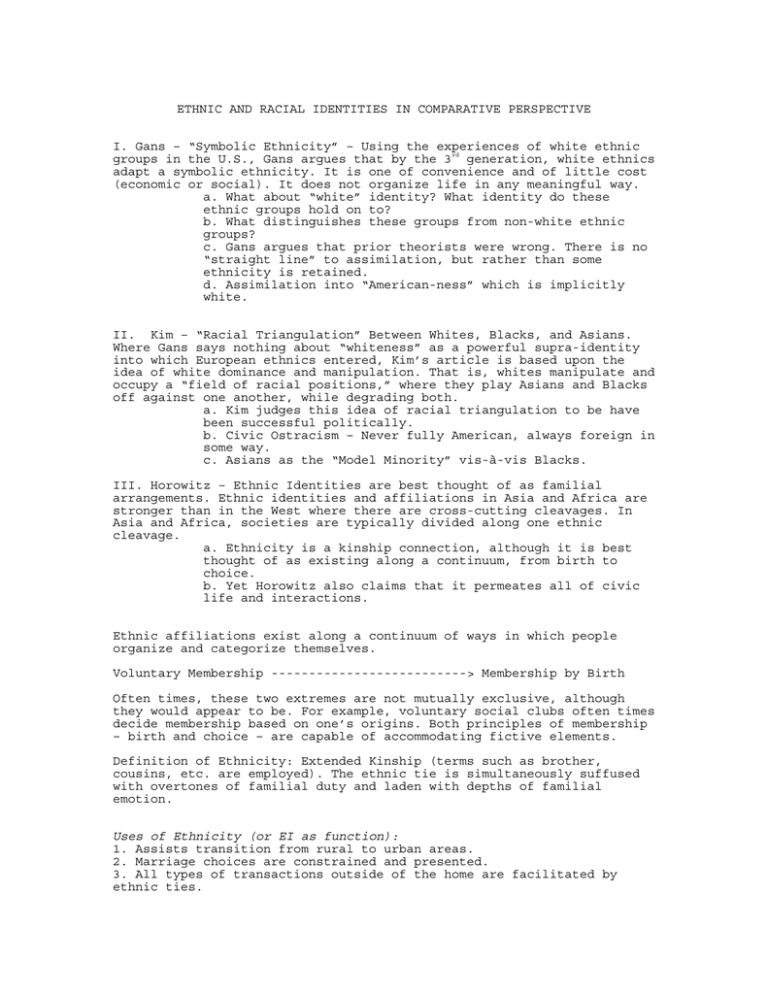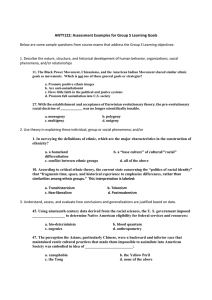ETHNIC AND RACIAL IDENTITIES IN COMPARATIVE PERSPECTIVE
advertisement

ETHNIC AND RACIAL IDENTITIES IN COMPARATIVE PERSPECTIVE I. Gans – “Symbolic Ethnicity” – Using the experiences of white ethnic groups in the U.S., Gans argues that by the 3rd generation, white ethnics adapt a symbolic ethnicity. It is one of convenience and of little cost (economic or social). It does not organize life in any meaningful way. a. What about “white” identity? What identity do these ethnic groups hold on to? b. What distinguishes these groups from non-white ethnic groups? c. Gans argues that prior theorists were wrong. There is no “straight line” to assimilation, but rather than some ethnicity is retained. d. Assimilation into “American-ness” which is implicitly white. II. Kim – “Racial Triangulation” Between Whites, Blacks, and Asians. Where Gans says nothing about “whiteness” as a powerful supra-identity into which European ethnics entered, Kim’s article is based upon the idea of white dominance and manipulation. That is, whites manipulate and occupy a “field of racial positions,” where they play Asians and Blacks off against one another, while degrading both. a. Kim judges this idea of racial triangulation to be have been successful politically. b. Civic Ostracism – Never fully American, always foreign in some way. c. Asians as the “Model Minority” vis-à-vis Blacks. III. Horowitz – Ethnic Identities are best thought of as familial arrangements. Ethnic identities and affiliations in Asia and Africa are stronger than in the West where there are cross-cutting cleavages. In Asia and Africa, societies are typically divided along one ethnic cleavage. a. Ethnicity is a kinship connection, although it is best thought of as existing along a continuum, from birth to choice. b. Yet Horowitz also claims that it permeates all of civic life and interactions. Ethnic affiliations exist along a continuum of ways in which people organize and categorize themselves. Voluntary Membership --------------------------> Membership by Birth Often times, these two extremes are not mutually exclusive, although they would appear to be. For example, voluntary social clubs often times decide membership based on one’s origins. Both principles of membership – birth and choice – are capable of accommodating fictive elements. Definition of Ethnicity: Extended Kinship (terms such as brother, cousins, etc. are employed). The ethnic tie is simultaneously suffused with overtones of familial duty and laden with depths of familial emotion. Uses of Ethnicity (or EI as function): 1. Assists transition from rural to urban areas. 2. Marriage choices are constrained and presented. 3. All types of transactions outside of the home are facilitated by ethnic ties. Processes of Ethnic Fusion and Fission: Whether one or the other of these occurs depends on the political context. 1. Under colonialism – The establishing of colonial boundaries (both territorial, administrative, and social) can result in either subgroup amalgamation or aggregation/dis-aggregation. Changes in ethnic boundaries and the appearance of organized efforts can produce corresponding changes in culture: 1. Myths of common ancestry emerge or disappear 2. Music and other cultural practices reflect the new ethnic order of either aggregation or dis-aggregation. 3. Similarly the case with literature and folklore. The Utility of Ethnic Affiliations: 1. They help in the negotiation of social and business transactions. 2. Emotional support and meaning producing. Ethnicity and the Modern State: 1. Electoral Politics – Ethnic Parties 2. Can liberalism (individualism) work or be meaningful in highly divided societies. Ethnicity and Class: 1. Ethnic affiliations – Should they be viewed as just another way for economic and political elites to advance their own individual and class interests under the guise of the group.







